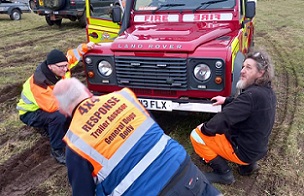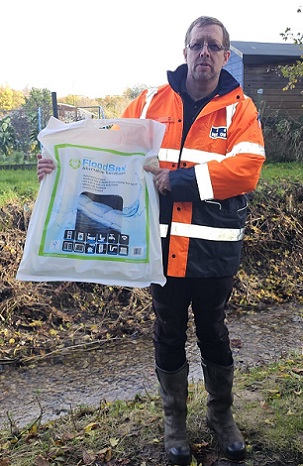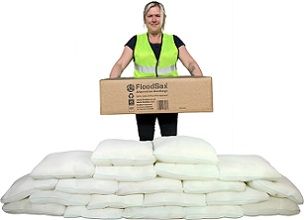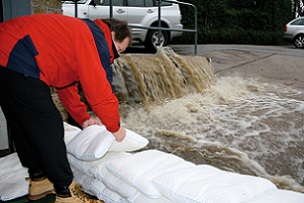 Norfolk and Suffolk 4x4 Response chairman Kalvin McLeod (right) on a joint training day with the fire service
Norfolk and Suffolk 4x4 Response chairman Kalvin McLeod (right) on a joint training day with the fire service
 Norfolk and Suffolk 4x4 Response events co-ordinator Rob Hawley with a pack of 5 FloodSax
Norfolk and Suffolk 4x4 Response events co-ordinator Rob Hawley with a pack of 5 FloodSax
 All these 20 FloodSax alternative sandbags came from this one easy-to-carry box
All these 20 FloodSax alternative sandbags came from this one easy-to-carry box
 FloodSax alternative sandbags keeping a torrent of floodwater at bay
FloodSax alternative sandbags keeping a torrent of floodwater at bay
The emergency off-roaders who now only use FloodSax alternative sandbags after terrible experience with traditional sandbags
A group of volunteers who use their hardy 4x4 vehicles to deal with any emergencies have discovered just how difficult it is to shift sandbags anywhere.
Their bad experience trying to move sandbags during a flooding emergency has led to Norfolk and Suffolk 4x4 Response now only using Floodsax alternative sandbags which are far easier to store, transport and deploy, especially when every second counts.
The team’s chairman, Kalvin McLeod, revealed that during an emergency volunteers were tasked with picking up sandbags from various locations around the counties and taking them to places on the border between the two which were under imminent threat of flooding.
The former RAF technician said that, in theory, it was a straightforward task but the reality was it proved to be a nightmare and, ultimately, virtually impossible to achieve.
Kalvin said: “We had to go to several locations to pick up the old-style traditional sandbags but when we got to some the sandbags had deteriorated and fallen apart while at others we found they’d been taken by council highways staff to weigh down road signs so, although on paper, there should have been 200 sandbags, in reality there were only around a dozen left.
“It took us four hours to drive around picking up what we could and then taking them to the flooding emergency but by then it was too late or we simply didn’t have enough sandbags. By the end of that mission we’d clocked up 150 miles, often driving in torrential rain or through floodwater.
“We thought there must be a better way and when we discovered FloodSax alternative sandbags we immediately thought ‘why hadn’t we known about these earlier?’.”
FloodSax come in boxes of 20 with five in each of the four packs inside. They are vacuum-packed which means they are incredibly space-saving to store and the 4x4 rescuers can get several boxes into each of their vehicles.
Kalvin said: “We keep the FloodSax at our store in Bungay 15 miles from Norwich which is central to our patch that’s 4,500 square miles but it also means we can simply throw the boxes in the back and get to any flooding incident quickly … and certainly anywhere within two hours.
“With sandbags, even if we can get enough we need to hitch up a trailer and load them onto that which takes several of us as they are so heavy and then we need help to unload at the other end.
“If it’s raining heavily or we are driving through floodwater that weight can increase dramatically. One of our members did an experiment and put sandbags weighing three tonnes into his trailer and then reversed it into a pond.
“After 20 minutes he drove it out, the trailer was weighed again and this time it was well over five tonnes.
“We have none of this with FloodSax which take only one person - a driver - to transport them.
“They can stay vacuum-packed right until we get to the scene and then be swiftly energised in the water to transform them into sandless sandbags.”
When Floodsax are fully immersed in water a special gelling polymer inside them absorbs the water and retains it so it expands to become an instant sandless sandbag weighing around 20kg. Its uniform shape and size makes FloodSax easier to stack than sandbags which are usually smaller and weigh around 15kg.
If councils task Norfolk and Suffolk 4x4 Response to take Floodsax to help their residents, the group then bills them for the FloodSax they’ve used and uses the money to replenish their stocks with more.
Norfolk and Suffolk 4x4 Response has 60 volunteers who will react quickly to any emergency call-outs to people stuck and needing help in remote locations inaccessible to other vehicles. The team has a phenomenal reputation with the average response time now just 37 minutes and the quickest response a mere 11 minutes.
Their services are very much in demand with hundreds of call-outs every year. Volunteers drive around 20,000 miles annually on urgent mercy missions.
Its events co-ordinator, Rob Hawley, said: “Our remit is to preserve and protect human life and property by providing equipment, vehicles and other resources to offer support in adverse conditions.
“Some days we can be transporting critical NHS staff or medical supplies in the snow or maybe helping transport firefighters to coastal flooding areas. Other days you might find us in the thick of remote forests keeping an eye on charity fundraisers to make sure they’re safe or patrolling an event with a paramedic in the passenger seat, ready to respond to any emergency. More commonly you’ll see us providing assistance to Lowland Search and Rescue by transporting search teams.
“And when things go wrong you may also find us in the middle of a muddy field helping to recover vehicles after a heavy downpour during a summer fete.”
Norfolk and Suffolk 4x4 Response is part of a national network of just over 30 groups covering the UK which has 3,000 members.
For more on Norfolk and Suffolk 4x4 Response go to https://norfolkandsuffolk4x4response.co.uk and to find out more about FloodSax alternative sandbags go to https://www.floodsax.co.uk